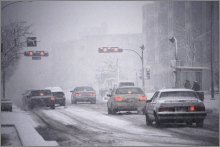|
|

|

How to Winterize Your Car ...
and Your Brain for Winter Driving
by www.SixWise.com Jack Frost is getting ready to fill much of the country with
slippery, icy, snowy and cold winter weather -- a treat for
snowball-loving schoolchildren, a hassle for commuters, and
their cars.
Blizzards, snowdrifts, freezing temperatures and ice storms
can mean big trouble for drivers, which is why it's so important
to prepare your vehicle, and your mind, for winter driving.
|

Keep a backpack filled with emergency items (flashlight,
jumper cables, warm clothes, snowbrush, extra food and
water, etc.) in your trunk during the winter -- it could
save your life in an emergency!
|
Preparing Your Car For Winter
With a few quick adjustments, your car will be better able
to handle the winter road, and keep you safe. These tips are
so simple that there's no excuse not to do them!
-
Change the car's oil. In the winter, it's harder
for your car's oil to circulate. Clean oil circulates
better than dirty oil, and thinner oil may be needed in
the winter (your vehicle owner's manual can tell you what
type of oil you need in the winter).
-
Check the antifreeze. If you haven't changed your
antifreeze in awhile, you should do so before winter.
Antifreeze will keep your car's engine, radiator and hoses
from freezing. You should keep a mixture of 50 percent
water, 50 percent antifreeze in your car (inexpensive
antifreeze testers are available to test the ratio on
your own).
- Make sure the tires are in good shape. If your
budget allows, or you live in an especially cold, stormy
or hilly area, investing in snow tires may be a good choice
to help improve your vehicle's traction.
At the very least, you need to make sure your car's tires
have the correct tire pressure, as they will shrink in
colder weather. If your tire isn't inflated properly,
you will have less traction and your tires can be more
easily damaged. Check your vehicle owner's manual for
correct tire pressures.
-
Inspect the battery. Cold temperatures can cut
a vehicle's battery power in half. Edmunds.com recommends
having your battery professionally tested if it's older
than three years, and keeping posts and connections corrosion-free.
-
Check your wipers and wiper fluid. When slushy
snow and ice hit your windshield, the wipers are the only
things keeping your visibility clear. Wiper blades last
about one year, so you should replace them if they're
older. Also check to make sure you have plenty of wiper
fluid; you'll be glad it's there when you need it.
-
Put an emergency kit in your trunk. An emergency
kit can save your life in case of an emergency, so grab
a backpack and stock it with these essential items recommended
by Edmunds.com:
-
A flashlight, flares and a first-aid kit
-
Jumper cables, a tool kit and tire chains
-
A blanket and some warm winter clothes
-
A bag of sand or salt, to use for traction if a tire
gets stuck
-
A snowbrush, ice scraper and snow shovel
-
A container of wiper fluid and paper towels
-
Some food and water
-
Avoid getting locked out. If your vehicle's door
locks freeze, heat the end of your key with a match or
lighter, then insert it into the lock. Alternatively,
use de-icer spray to unfreeze the lock.
Tricky Winter Driving Scenarios to Watch Out For
|

If your vehicle starts to skid on an icy road, ease
off the accelerator and steer in the direction you want
the car to go (then straighten the wheel when the car
begins to move in that direction).
|
You can prepare your vehicle all you want, but winter road
conditions can still catch you off guard. Here's how to handle
some of the more common winter driving hazards:
-
Ice patches: Ice forms first in shaded areas,
bridges, overpasses and intersections, and can be invisible
(black
ice). Increase your following distance and slow down
if ice may be present. Meanwhile, avoid making sudden
turns, accelerations or stops.
-
Poor visibility: Remove snow and ice from your
entire car, including lights, turn signals, roof, hood
and mirrors, and use low-beam headlights, which provide
better illumination in snow than high-beams. Use wiper
fluid frequently to keep your windshield clear.
-
Skidding: If your vehicle starts to skid on a
snowy or icy patch, ease off the accelerator, then steer
in the direction you want the car to go. When the car
begins to move in that direction, straighten the steering
wheel.
-
Getting stuck. If your vehicle gets stuck in the
snow, put sand or salt under the drive wheels, then straighten
the wheels. Next, accelerate slowly (but not so much that
you spin the tires).
-
Snowy roads. Driving on snow, whether it's slushy,
hard-packed, slippery, filled with ruts or soft, takes
some adjustments from normal driving. Reduce your speed,
increase your following distance and avoid sudden turns
of the steering wheel, sudden braking or sudden accelerating,
all of which could cause your vehicle to skid. Anti-lock
brakes are most effective when firm, constant pressure
is applied to the pedal (in an emergency you can push
the pedal all the way to the floor).
Recommended Reading
The
Top Six Winter Driving Dangers and How to Handle Them Safely
12
Tips to Lower Your Heating Bill This Winter
Sources
Edmunds.com
CNNMoney.com
AAA:
Auto Safety & Maintenance
To get more information about this and other highly important topics, sign up for your free subscription to our weekly SixWise.com "Be Safe, Live Long & Prosper" e-newsletter.
With every issue of the free SixWise.com newsletter, you’ll get access to the insights, products, services, and more that can truly improve your well-being, peace of mind, and therefore your life!
|
|
|
|